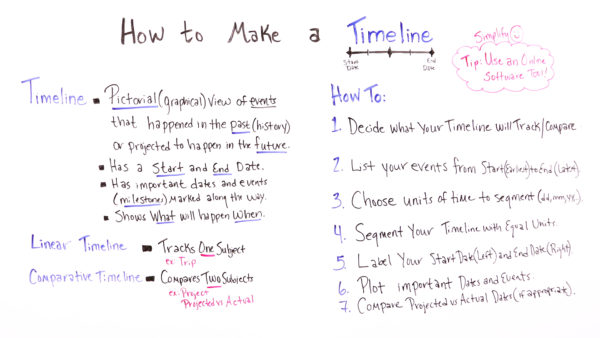Timelines are key to scheduling any project, and Jennifer Bridges, PMP, shows you how to make one.
Here’s a shot of the whiteboard for your reference!

In Review – How to Make a Timeline:
Almost everything we do involves a timeline, said Jennifer, if it has a start and an end date. That’s a given. But when we’re trying to plan a project or work on a longer task, we need to consider the nuances of scheduling, particularly if we’re working with others to get the job done on time. So how do you make a timeline so that others can share?
There are different ways you can present a timeline:
- Graphically, as in a picture view of events that happen in the past (history) and which are projected to occur in the future
- They need to have a start and an end date
- Milestones are points in the timeline that represent major dates or events, milestones can help you have a more effective project schedule
- And it needs to show what will happen and when
Jennifer noted that there are two basic types of time lines.
- Linear, which tracks one subject, such as a trip you are taking
- Comparative, which compares two subjects, such as a project with projected versus actual data
Create a project timeline in 7 simple steps:
- Decide what your timeline will track or compare
- List the events from start to finish
- Choose units of time to segment the events, such as days, months, years, etc.
- Segment your timeline with equal units
- Label your start date on the left and your end date on the right
- Plot the important dates and events
- Compare project versus actual dates, if appropriate
Project management planning depends on accurate timelines to schedule your project. By mapping out the events or tasks along a timeline you can get a better feel for how long a project will take and what resources you’ll need to bring it to a successful conclusion within the allotted time and budget.
Pro-Tip: It’s best to start simple and collect all the many tasks that are necessary to successfully complete the project. Then you can prioritize them. You’ll find that some of the tasks are not crucial and could be done later or not at all if your schedule, budget and resources don’t allow.
Thanks for watching!
Transcription:
Today we’re talking about how to make a timeline. In reality, we’re always making timelines. If I go on a trip or a vacation, I have a timeline. My videographer is planning her wedding and trust me, she has a timeline.
I also mentor graduate students and they have a timeline for their curriculum and graduation. So, whether it’s personally or professionally, they’re very important to help us get things done. So, let’s look at what a timeline is.
It’s a pictorial or graphical view of events that happen either in the past or are projected to happen in the future. A timeline also has a start date and end date and also has important dates and events marked all along the way.
It also shows what will happen and when. So, there are two specific types of timelines that we work with. The first one is a linear timeline and it tracks one subject. So, an example would be if you go on a trip, that’s a linear timeline.
A comparative timeline compares two subjects. So, think about a project where you may be comparing projected dates versus your actual dates. So, let’s look at how we go about creating or making our timeline.
First of all, you wanna decide what your timeline will track or compare. So, again that is, are you using a linear or comparative timeline? Then, list your events from the start date to the end date or the earliest to the latest on your timeline.
Then choose the units of time to segment. Are you going to measure in days? In months? Or maybe years? Then you wanna segment your timeline with those equal units along the way.
Then you wanna label your start date on the left, and your end date on the right so you know what specific point in time on the timeline you’re looking at.
Then you wanna plot your important dates and events all along the way on your timeline. Then if appropriate, you’re gonna go back and compare your projected and your actual dates. And again, a good example of that is, if you’re either working on or you’re managing a project.
So, a great tip here is to use an online software tool. Think about it. If you’re on a project, all the team members have their own timeline. Maybe if you’re managing the project, you also have a timeline.
So by using an online software tool, all of those are managed and maintained inside the tool and everyone can have access and insight into them. So, I think that helps to simplify things.
So, if you need a tool that can help you with your timeline, then sign up for our software now at ProjectManager.com.

